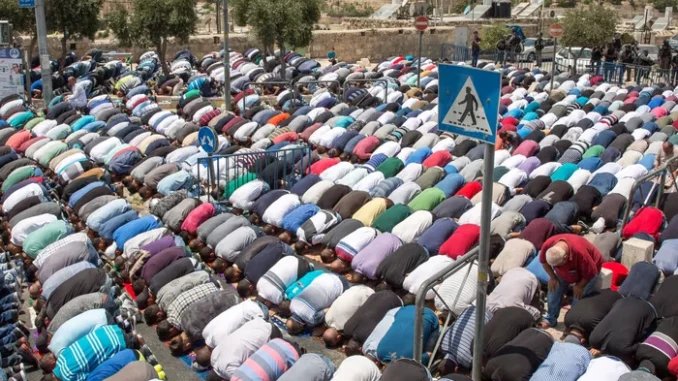There’s a debate raging over the numbers of Jews and Arabs living between the Mediterranean and the Jordan River. At its center are two vastly different views, each of which merits serious consideration
By Michael Milshtein, HAARETZ
A 2017 photo of Friday prayers in East Jerusalem. Yasser Arafat famously talked about “a future victory via the Palestinian womb.” Credit: Emil Salman
Around two months ago, the director of the Palestinian Authority’s Central Bureau of Statistics issued an unusual statement, one that in more normal times would have resonated on both sides of the Green Line. Dr. Ula Awad announced that for the first time, according to the bureau’s findings, parity exists in terms of the number of Jews and Arabs living between the Mediterranean Sea and the Jordan River. Each group numbers approximately 7 million people, she maintains. Among the Palestinians, some 3.2 million live in the West Bank and East Jerusalem, 2.1 million in the Gaza Strip, and within Israel there are 1.7 million Arab citizens.
The numbers are inflated by over 1 million. Also Gaza 2.1 m should not be counted. For a more detailed analysis Ettinger reports in 2022 Inflated Palestinian Demography. According to Ettinger the Arabs, between the river and Gaza, represent only 32% of the total population and their percentage is falling. It is the hope of the Jordan Option to reduce this to 27%.
The announcement was swallowed up amid the political and security turmoil in Israel, but it constitutes a critical issue for both societies. In a period in which the discourse on territorial separation between the two sides is waning, another discourse is intensifying: Israeli-Palestinian, intra-Israeli and intra-Palestinian debates over the “demographic genie,” an issue that has been integral to the conflict from its inception.
The demographic question has always been a central definer of the Zionist movement, which sought to move a dispersed Jewish collective to a single territory, and to forge in it a sovereign state in which it constitutes the majority. For more than a century, two currents have existed in the demographic discourse on the Jewish side, consistent with Zionism’s central tenets. One current embodies anxiety about being swallowed up into an Arab majority, with which it believes there is no possibility of a joint political entity, so that it favors the partition of the country on the basis of two entities, one of which would contain a Jewish majority. The second current clings to the belief that a Jewish majority already exists or will soon be achieved in the land, so that partition is unnecessary and the aspiration should be for sovereignty over the entire Land of Israel.
These conceptions may once have corresponded to a left-right division, but over the years the discussion has crossed the political dividing lines. Yitzhak Tabenkin, one of the fathers of the Ahdut Ha’avoda (Hakibbutz Hameu`chad movement), was an advocate of Zionist control over the whole Land of Israel and accordingly rebuffed with disdain demographic forecasts that predicted the end of the Zionist project in the absence of territorial partition. In contrast, Ariel Sharon, who for years urged that the Palestinians be pushed into the east bank of the Jordan, eventually came around to calling for partition, one of his arguments being that this would ensure Israel’s Jewish and democratic character.
David Ben-Gurion, the chief promoter of the strategy of territorial division, embodied in concept and in deeds an image of the state as it existed until 1967: a separate entity possessing a Jewish majority, even if only in part of the Land of Israel, but without abandoning a dream of eventual extension of Jewish rule to the entire land. However, the country’s first prime minister recognized that the dream needed to be postponed indefinitely in order to concentrate on the problems of the present – above all, the absorption of new immigrants and the development of the country’s economy and its armed forces.
In the 1950s, Ben-Gurion gave occasional thought to conquest of the West Bank and the Gaza Strip, but ultimately dropped the idea, partly out of concern that such a move would upset the demographic balance in Israel. The demographic anxiety did not disappear entirely in the state’s first two decades, but it receded in light of a clear geographical buffer that existed between Israel and the surrounding region, together with a continuing rise in the proportion of Jews in the country’s population.
The events of 1967 generated a huge surge in demographic discourse in Israel, centering around a dilemma that hadn’t existed before the Six-Day War. On the one hand, the vision of taking control of the whole of the historic Land of Israel had materialized; but on the other hand, Israel found itself directly ruling a multitude of Palestinians, a situation that gave rise to trenchant questions about a possible undermining of the demographic balance, which would in turn affect the state’s character.
The demographic debate became the core of the political-strategic discourse about Israel’s future, and it remains unresolved to this day, both because Israelis can agree neither on the question of the boundaries of the Land of Israel, nor on the future legal status of Palestinians in the territories. The advocates of separation continue to warn of a growing fusion of Israel and the territories, which could mean the loss of the Jewish majority and the emergence of a Middle Eastern version of Rhodesia or South Africa.
With his characteristic sarcasm, Levi Eshkol, Israel’s prime minister from 1963 to 1969, likened the country’s rule over the Palestinians to an “overweight bride” that came along with the dowry of the territories received by Israel, and expressed anxiety that the demographic balance would be upset, as happened in Cyprus and Lebanon. Yigal Allon, who initially supported the Greater Israel idea, after 1967 became the foremost advocate of physical separation, though his goal was to transfer part of the West Bank to Jordan, not to establish a Palestinian state in the territories. And Prime Minister Yitzhak Rabin’s rationale for the Oslo process was the fear that either one state or a binational state would come into being, and that that would threaten Israel’s Jewish and democratic essence.
Evidence of the diverse student population at the Hebrew University of Jerusalem.Credit: Olivier Fitoussi
On the other side is a camp that has always rejected the intimations of a demographic apocalypse: from Shimon Peres in the early 1970s, to Menachem Begin nearly a decade later and most of today’s right-wing leaders. They denied and continued to deny the accuracy of the data about the number of Arabs in the West Bank and the Gaza Strip, and maintain that the fertility of Arab women is constantly declining while that of Jewish women is rising rapidly, and also that Palestinian emigration is accelerating. Their unrelenting hope is for waves of Jewish immigration that would boost the ratio of Jews in the population, such as occurred 30 years ago with the aliyah from the former Soviet Union – a turn of events that, in their view, attests to the basic inability of the science of demography in predicting the future.
In 2009, Uri Elitzur, one of the leaders of the settlers, urged that all West Bank Palestinians be granted Israeli citizenship, shrugging off the demographic concern with the argument that it would be no calamity if there were 20 Arab MKs out of 120. The late Moshe Arens, from Likud, who served as defense minister, noted that even if the Arabs were to constitute 30 percent of the country’s population, Israel would be able to retain its present character. There are now many voices on the right that call for Israeli sovereignty to be applied unilaterally to the West Bank, usually amid vagueness about the fate of the Palestinians there.
Academics have always played a central role in this demographic discourse. As early as 1898, historian Simon Dubnow cautioned Theodor Herzl that the Jews would not succeed in altering the demographic balance in Palestine, and that they were fated to remain a minority even in the year 2000. Prof. Roberto Baki, the founder of Israel’s Central Bureau of Statistics, is considered the spiritual father of the demographic prophets of doom. On the eve of the state’s establishment, he warned that the demographic balance was tilting against the Jews, and accordingly called on David Ben-Gurion to delay Israel’s declaration of independence. After 1967, Baki became the oracle of the separation advocates, in light of the forecasts he presented to the country’s leaders to the effect that by 1987 an Arab majority would emerge between the Mediterranean Sea and the Jordan River.
Contrariwise, some researchers from the right-wing camp maintain that today there are a million, or even 1.5 million, fewer Palestinians in the West Bank than is usually claimed, and that therefore there is nothing to prevent the application of full Israeli sovereignty there.
The demographic debate was thus never a mere professional disagreement about methods for calculating the population size, or over the appropriate methodology for formulating future estimates. It was in fact a political and ideological debate over identity and aims.
For the Palestinians, too, demography bears strategic weight. Their point of departure naturally reflects the complete opposite of the Zionist approach. Before 1948, the Palestinians viewed aliyah – Jewish immigration to Mandatory Palestine – as a major existential threat, on a par with or even more serious than land purchases by Jews. From the Palestinian viewpoint, demographics encapsulates the essence of Zionism, which as they see it aspires to supplant the land’s indigenous people, the former majority, with migrants, using methods of dislocation and dispossession.
After 1967, the Palestine Liberation Organization discovered that demographics need not only be a threat; it also constitutes an opportunity for pressuring Israel, whose leaders are in constant fear of a loss of the country’s Jewish majority. Hence Yasser Arafat’s famous remark about “a future victory via the Palestinian womb.”
The intensification of this discussion among the Palestinians of late also indicates a return to the roots of the conflict. Now a struggle is afoot between two communities that have lost interest in a political agreement and are clashing over the question of which side possesses a numerical majority. The demographic discourse among the Palestinians is being conducted parallel to the growing support among them for the one-state idea, after they despaired of the possibility of ever reaching a political settlement.
Many Palestinians see the one-state concept as an opportunity to overcome Israel from within. In the first stage, it would enable the realization for them of civil rights and material gains, without their having to abandon their identity or national aspirations; and subsequently it would bring about a change in the country’s character, not least through the return of the Palestinian refugees. Takeover would thus be possible through democratic means.
Gaza City beach. It’s time for a deeper, more realistic Israeli discourse on the Palestinian question. Credit: Mohammed Salem / Reuters
The data from recent years ostensibly reinforces those who mock “demographic paranoia.” Fertility among Arab women, particularly in the Muslim population, has been in a prolonged decline on both sides of the Green Line, the result of social-cultural modernization. More Arab women are availing themselves of higher education and are entering the labor market, bringing about a rise in the average age of marriage and a lower birthrate, accompanied by a rise in the divorce rate. In the territories, fertility has declined from a rate of 4.6 births per woman, 20 years ago, to 3.8 births today (3.8 in the West Bank, 3.9 in the Gaza Strip); and among Muslim women in Israel, the fertility rate today is 2.9, down from 9.2 in 1960, and compared to 3.0 among Jewish women, 1.85 among Christians and 1.94 in the Druze community.
Nonetheless, these figures should not be a cause for optimism on the Jewish side. Almost half the Palestinians on both sides of the Green Line are under the age of 18, signifying more rapid and higher demographic growth than in Jewish society, and an ongoing reduction in the numerical disparity between the societies. The overall Palestinian population has doubled since 2000, and according to various forecasts, it will double again within a decade and a half to two decades.
Across more than a century, the prophets of demographic doom came to be viewed like the boy who cried “wolf,” as many apocalyptic forecasts indeed proved false. In practice, however, the fateful question about the demographic balance between “the sea and the river” remained unanswered. Despite the critical character of the question, the Israeli leadership, particularly over the past two decades, has not found it fit to consider it in depth. This is due to the complete breakdown of any negotiations on a final-status agreement (which would require the input of a demographic database); to the difficulty of digesting abstract statistical data and understanding long-term processes; and also to a lack of desire in the political arena to fully clarify the situation, something that precise statistics would make possible.
The debate on the numbers has intensified in recent weeks, in the wake of the report of parity having been reached. The argument revolves around two numerical claims, with an almost incomprehensible disparity between them. On the one hand there are those, like Israeli geographer Arnon Soffer, who maintain that approximately six million Palestinians currently reside in the Gaza Strip, the West Bank and East Jerusalem (a higher number than what the PA’s Central Bureau of Statistics claims), and that there are more Arabs than Jews living between the Mediterranean and the Jordan River; while at the same time, other estimates place the number of Palestinians who live beyond the Green Line at only four million.
A country that plans to go on existing into an indefinite future cannot sustain such acute numerical uncertainty – it renders impossible strategic planning and the ability to make critical decisions. Accurate data is a foundation for any government decision: from applying full or partial sovereignty in the West Bank, to demarcating a boundary line by agreement or unilaterally. It is also a necessary underpinning for the interim ideas that have been evolving in Israel in recent years as alternatives to strategic decisions: an aspiration to preserve the status quo while wrapping it in material cosmetics such as “economic peace” and largely “shrinking the conflict.”
Whatever government is sworn in after the November election must solve the demographic conundrum. The trenchant dilemma will of course intensify if it turns out that the data about parity or near-parity between the two populations is correct – as is claimed by most of the research bodies in Israel, governmental and academic alike.
Clarifying the facts will also turn out to be the right course of action should a serious discussion develop about applying Israeli sovereignty in the West Bank, in which case the Arabs are likely to constitute 41 percent of the population of the Land of Israel. That scenario calls for a realistic collective gaze at the future and a clarification of whether the public in Israel is aware that it’s moving toward life in a single entity.
And overall, the time has come for a far deeper, more realistic, probing discourse to be conducted in Israel on the Palestinian question. It turns out that it’s impossible to make it go away, or to wrap it in vague formulations and baseless illusions about economic growth. Those are models of existence that are suited to postmodern and post-national societies, but not to two peoples that are still locked in a national struggle that is fraught with hostility. A clarification of the demographic reality would force the Israeli public to confront what the future portends and its implications, sharpen the strategic alternatives and pinpoint the issues that require historic decisions.
Dr. Michael Milshtein is head of the Palestinian Studies Forum at the Moshe Dayan Center for Middle Eastern and African Studies at Tel Aviv University, and a senior analyst at the Institute for Policy and Strategy, Reichman University.






@Ted Belman There are 8 million Arabs in Judea and Samaria now?
@Sebastien
Correct
@Ted Belman 400,000 is 5 percent of 8 million.
@Sabastien Zorn
I did not say it right. I amended it to say, enough would emigrate to reduce the Arab percentage from 32% to 27%. That would require about 400,000 to emigrate.
One of the reasons I didn’t say double that reaction is because The current Israeli government and maybe even a rightwing replacement, is not prepared to do what is necessary to achieve such mass emigration. This requires incentivizing emigration and de-incentivizing remaining.
I left out emigration from Gaza entirely.
Liberals always play this trick. Nobody is advocating immediate application of sovereignty of any part of the territories except Area C where Jews constitute the overwhelming majority at last count though in light of the disturbing reports of entire Pal cities being illegally constructed on public land with EU funding and the presumably poorly guarded border between Area C and the PA misruled autonomous areas, a re-examination is sorely needed.
I was surprised and bemused to read that the Jordan Option is now only projected to get 5 percent of the Arabs to leave Yesha when earlier I’m pretty sure it was claimed that most would leave voluntarily including terrorists and other criminals whi could be deported to Jordan. If so, obviously that’s not good enough.